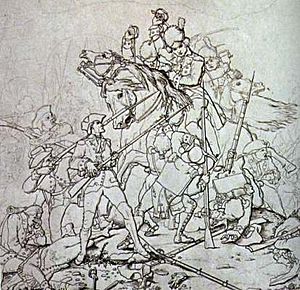Battle of Waxhaws facts for kids
Quick facts for kids Battle of Waxhaws |
|||||||
|---|---|---|---|---|---|---|---|
| Part of the American Revolutionary War | |||||||
 Sketch of the Waxhaw Massacre thought to be for a 19th century lithograph |
|||||||
|
|||||||
| Belligerents | |||||||
| Commanders and leaders | |||||||
| Strength | |||||||
| 150 dragoons and mounted infantry | 420 380 infantry 40 dragoons |
||||||
| Casualties and losses | |||||||
| 5 killed 12 wounded |
113 killed 150 wounded and paroled; 53 captured |
||||||
The Battle of Waxhaws was a fight during the American Revolutionary War. It happened on May 29, 1780, in Lancaster, South Carolina. The battle was between American forces led by Abraham Buford and British-Loyalist troops led by Banastre Tarleton.
Buford's men tried to surrender during the battle. But a misunderstanding led to more fighting. Tarleton's horse was shot, trapping him. His troops thought he was dead and attacked fiercely. Many American soldiers were killed or badly hurt, even after they had stopped fighting. This event became known as the "Waxhaw massacre."
After this, "Tarleton's quarter" became a saying. It meant that no prisoners would be taken in battle. This battle made many Americans angry. It helped them decide to join the fight against the British.
Contents
Why Did the Battle of Waxhaws Happen?
After losing a big battle at Saratoga in 1777, the British changed their plan. They decided to focus on the southern colonies. They thought they had more supporters there. Their goal was to win the South first, then take back the North.
They started by capturing Savannah, Georgia, in 1778. In 1780, General Sir Henry Clinton captured Charleston, South Carolina. This was a major victory for the British.
Who Was Involved in the Battle?
Colonel Abraham Buford led about 380 American soldiers. Most of his men were new recruits from Virginia. They did not have much battle experience. Buford was trying to reach Charleston to help defend it. But the city surrendered before he could get there.
Buford then started heading north. He was joined by some other American soldiers. Meanwhile, General Clinton wanted to control the South Carolina area. He sent Lieutenant Colonel Banastre Tarleton to chase Buford.
Tarleton led about 270 men. His force included British soldiers and Loyalists. Loyalists were American colonists who supported the British king. Tarleton's troops were very fast.
What Happened Before the Battle?
Tarleton quickly caught up to Buford's troops. He sent a messenger to Buford. The messenger carried a white flag, which meant he wanted to talk. Tarleton told Buford to surrender. He even made his own force sound much larger than it was.
Tarleton warned Buford that he would only ask for surrender once. Buford refused. He said he would fight until the very end. Buford then started marching his troops north again.
Tarleton did something against the rules of war. He kept his troops moving forward while the talks were happening.
The Battle of Waxhaws
Around 3:00 pm, Tarleton's lead troops caught up with Buford's rear guard. The American rear guard was quickly captured. Their leader was badly hurt. Buford stopped his main column. He formed a battle line in some open woods.
Tarleton's cavalry charged the American line. Buford waited until the enemy was very close before ordering his men to fire. This was a mistake. The British riders were on them before the Americans could fire more than once.
As Tarleton's cavalry attacked, many Americans began to drop their weapons. They tried to surrender. According to American accounts, Buford sent a white flag to Tarleton. But Tarleton was trapped under his horse. His horse had been shot during the attack. He might not have seen the flag.
British and Loyalist troops were very angry. They thought the Americans had tricked them by shooting Tarleton's horse during a surrender attempt. The fighting continued fiercely. Many Americans were killed or wounded even after they tried to surrender.
Tarleton reported that 113 American soldiers were killed. Another 147 were wounded. The British lost only 5 men killed and 12 wounded.
Historians have different ideas about what happened. Some say Tarleton was responsible for a massacre. Others say that battles like this often had very uneven casualties. Tarleton himself said his men were very angry and hard to control.
What Happened After the Battle?
After the battle, people from nearby areas helped the wounded. A young Andrew Jackson was among those who helped. News of the battle spread quickly. People were upset about how the Americans had been treated.
The battle helped the British control South Carolina for a short time. But it also made many people angry. Many who had stayed neutral now joined the American side. "Tarleton's Quarter!" became a rallying cry. It meant "no mercy!"
This event inspired new American militia groups. These groups fought against the British. They helped win important battles later, like the Battle of Kings Mountain.
Legacy of the Battle
The area where the battle happened is now called Buford. The battlefield is a local park. It is also listed on the National Register of Historic Places. This helps preserve the site for future generations.



